Gday team
This has been offered to me. I would like to authenticate it. What do you think?
Bill
Sorry I lost the pics
What do you think of this?
I am trying to date and locate this one.
cheers
Bill
 Attachment: 31.21 KB
Attachment: 31.21 KB

 Attachment: 42.62 KB
Attachment: 42.62 KB
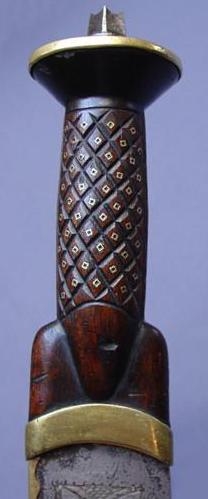
 Attachment: 60.01 KB
Attachment: 60.01 KB
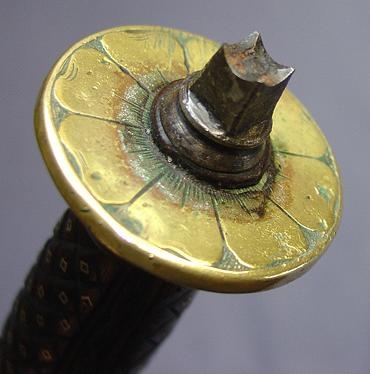
 Attachment: 63.45 KB
Attachment: 63.45 KB
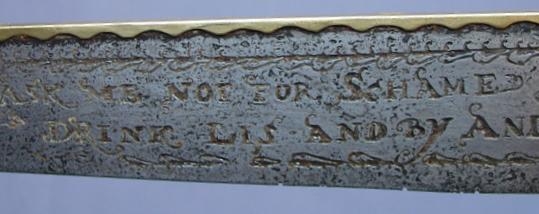
 Attachment: 53.66 KB
Attachment: 53.66 KB
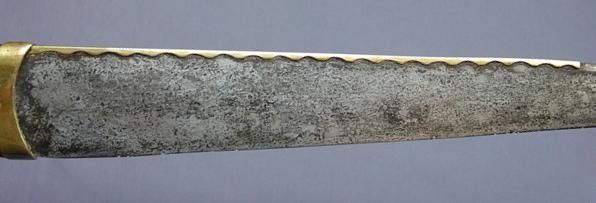
 Attachment: 25.82 KB
Attachment: 25.82 KB

 Attachment: 147.28 KB
Attachment: 147.28 KB

 Attachment: 48.34 KB
Attachment: 48.34 KB
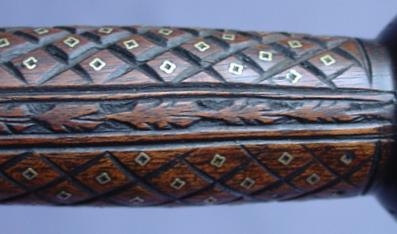
What do you think of this?
I am trying to date and locate this one.
cheers
Bill








| William Atkin wrote: |
| Sorry I lost the pics
What do you think of this? I am trying to date and locate this one. cheers Bill |
How does the inscription read in its entireity?
The blade looks authentic. The grip, however, looks quite new and the cross hatching is very sharp for what otherwise appears to be a late 17th/early 18th c. dirk. The engraving on the pommel is also unusual for what appears to be a Scottish dirk.
I'm not sure what you have there and it could be a very old blade with new grip and fittings.
Hello Lin
Yes, It is eaither later or a very well preserved (? by a gentleman) period piece.
The inscription says
"Ask me not for schame
drink Lis and by ane"
I take this to mean
"do not use me for shameful deeds
when drunk, to defend lies or for greed"
Bill
Yes, It is eaither later or a very well preserved (? by a gentleman) period piece.
The inscription says
"Ask me not for schame
drink Lis and by ane"
I take this to mean
"do not use me for shameful deeds
when drunk, to defend lies or for greed"
Bill
| William Atkin wrote: |
| Hello Lin
Yes, It is eaither later or a very well preserved (? by a gentleman) period piece. The inscription says "Ask me not for schame drink Lis and by ane" I take this to mean "do not use me for shameful deeds when drunk, to defend lies or for greed" Bill |
That could be what it says. Spelling was inconsistent in Old Scots as it was in Old English. "Ane" however, means "one". I have seen that motto on other dirk blades.
I am still inclined to think that the blade is late 17th/early 18th c. and that the grip is a relatively new replacement. I would have expected to see knot work on a grip from that era rather than simple cross hatching with studs, but who knows. The entire piece is probably "antique" but I am betting that grip was installed some time during the Victorian era or later.
That inscription is identical to that on a documented piece. I forget where I read about it--maybe Culloden: The Swords and the Sorrows. The author interpreted it as meaning: "Don't ask me for this. Drink less and buy one." One assumes this would be reserved for an especially fine arm, but are there really two of them still existing? It's a red flag to me. But there are lots of spurious inscriptions on genuine antiques. Some of them are even contemporary to the antique. "Andrea Ferrara" is a good example. It's certainly plausible that the inscription in question could have been passed around freely.
The hilt could have been cleaned. If it's modern, it's still very fine work. Beautiful, in fact. Look at those brass pins (approx. 100). They're made from tiny strips of metal folded into shape. See the overlap on some of them? Making and mounting those required a HUGE amount of work. Why go to that trouble when the market prefers knotwork? And that scalloped brass backing....
If this were a modern piece by a well-known cutler I wouldn't be surprised to see a price of $700+. If an unknown master cutler can get that kind of price legally, I think he's not likely to risk jail and fines for fraud. But maybe it is composite work honestly commissioned and honestly completed, but now separated from its collector. Do antique dealers ever mislabel or otherwise lead astray? Maybe once or twice....
I lean toward "authentic, with over-cleaned or refinished hilt." The price could tip me the other way, though. Either crazy expensive or crazy inexpensive would make me suspicious.
The hilt could have been cleaned. If it's modern, it's still very fine work. Beautiful, in fact. Look at those brass pins (approx. 100). They're made from tiny strips of metal folded into shape. See the overlap on some of them? Making and mounting those required a HUGE amount of work. Why go to that trouble when the market prefers knotwork? And that scalloped brass backing....
If this were a modern piece by a well-known cutler I wouldn't be surprised to see a price of $700+. If an unknown master cutler can get that kind of price legally, I think he's not likely to risk jail and fines for fraud. But maybe it is composite work honestly commissioned and honestly completed, but now separated from its collector. Do antique dealers ever mislabel or otherwise lead astray? Maybe once or twice....
I lean toward "authentic, with over-cleaned or refinished hilt." The price could tip me the other way, though. Either crazy expensive or crazy inexpensive would make me suspicious.
| Sean Flynt wrote: |
| That inscription is identical to that on a documented piece. I forget where I read about it--maybe Culloden: The Swords and the Sorrows. The author interpreted it as meaning: "Don't ask me for this. Drink less and buy one." One assumes this would be reserved for an especially fine arm, but are there really two of them still existing? It's a red flag to me. But there are lots of spurious inscriptions on genuine antiques. Some of them are even contemporary to the antique. "Andrea Ferrara" is a good example. It's certainly plausible that the inscription in question could have been passed around freely.
The hilt could have been cleaned. If it's modern, it's still very fine work. Beautiful, in fact. Look at those brass pins (approx. 100). They're made from tiny strips of metal folded into shape. See the overlap on some of them? Making and mounting those required a HUGE amount of work. Why go to that trouble when the market prefers knotwork? And that scalloped brass backing.... If this were a modern piece by a well-known cutler I wouldn't be surprised to see a price of $700+. If an unknown master cutler can get that kind of price legally, I think he's not likely to risk jail and fines for fraud. But maybe it is composite work honestly commissioned and honestly completed, but now separated from its collector. Do antique dealers ever mislabel or otherwise lead astray? Maybe once or twice.... I lean toward "authentic, with over-cleaned or refinished hilt." The price could tip me the other way, though. Either crazy expensive or crazy inexpensive would make me suspicious. |
That inscription is mentioned in James D. Foreman's book on Scottish dirks. The translation you provided, now that I look at it, is probably correct. My Scots is not very good and non-standard spelling doesn't help. Now that you mention the backing, it does look like an addition, but the blade looks authentic to me. Andrea Ferrara was more of a trademark than a spurious marking, inmho. And, the idea that there were two or more blades engraved with the motto is quite plausible. The markings look original to me.
There is no doubt that the hilt took a lot of work. Cutting that cross hatching on a convex surface - and keeping it straight - is no mean feat. However, viewed as a whole, the hilt simply doesn't reflect the era of the blade. And, the cross hatching is very sharp, as I mentioned in my first post. I still think the hilt is Victorian or maybe even early 20th c. which is why it is not carved with knot work.
If this is priced right I would buy it, for the blade if nothing else. A modern maker would probably ask at least $700 for something like it - and get it. However, all that being said, I would want some provenance if the price is on up there and it is represented as an antique.
Nice dirk though.
I'm going to have to chime in that it is an antique blade and furniture, but with a (possible) Victorian hilt replacement. I have seen many attempts at antiquing metal parts, but this looks to be really old - the patina looks quite natural, and the design of the brass work seems to fit a late 17th - early 18th century style. In any case, it's a beautiful piece, well worth a grand or more, IMO. Thanks for sharing!
So, a fine 19th c. hilt on an 18th c. blade? Works for me! It's a beautiful piece, no matter what.
Yeah, my Andrea Ferrara analogy is weak....it seems to have been used as you indicate, as a generic indicator of quality rather than an attempt to fool they buyer.
Yeah, my Andrea Ferrara analogy is weak....it seems to have been used as you indicate, as a generic indicator of quality rather than an attempt to fool they buyer.
The sentiment on the dirk was a very common one, Sean. I have seen it on numerous items from the period including powder horns. I have also seen it expressed as "Ask me not for shame. My Meister wil deny thee. Drink les and by ane.' And I agree with the interpretation 'Shame on you for asking to borrow me. If you drank less you could afford me.' Having seen a number of dirks with this type of inscription and other s in much the same style (ex: "God Loves King James", etc.) gives me the thought that these blades may have been made up in Germany for export to Scotland with 'traditional'
mottos for the trade.
As to the providence, the grip is in just a whole lot better shape than the blade. The brass strip isn't an issue as it is more of a mark of authenticity. Other than decoration, it served the purpose of 'grabbing' a sharp blade sliding along its edge. Brass being softer than steel would 'catch' the blade.
Personally, I believe you have an authentic pommel nut, pommel cap and blade on a replacement grip. I love the dirk as it is a unique one.
By the way, many of us who fancy dirks sometimes get caught up in comparing everything we see to the 'Dirty Dozen' we see illustrated in many books and picture trails that are part of important Scottish museum collections. The reserve collections - not displayed - probably contain hundreds of dirks. We judge based on the few we see illustrated often when the whole body of extant work is much more diverse and voluminous.
mottos for the trade.
As to the providence, the grip is in just a whole lot better shape than the blade. The brass strip isn't an issue as it is more of a mark of authenticity. Other than decoration, it served the purpose of 'grabbing' a sharp blade sliding along its edge. Brass being softer than steel would 'catch' the blade.
Personally, I believe you have an authentic pommel nut, pommel cap and blade on a replacement grip. I love the dirk as it is a unique one.
By the way, many of us who fancy dirks sometimes get caught up in comparing everything we see to the 'Dirty Dozen' we see illustrated in many books and picture trails that are part of important Scottish museum collections. The reserve collections - not displayed - probably contain hundreds of dirks. We judge based on the few we see illustrated often when the whole body of extant work is much more diverse and voluminous.
Thanks team
Can anyone show a similar handle that can match this one?
Bill
Can anyone show a similar handle that can match this one?
Bill
Truly am amazed that the point has remained intact!I'd expect it to have been broken off a few times and re-ground........
| William Atkin wrote: |
| Thanks team
Can anyone show a similar handle that can match this one? Bill |
Bill...
I have NEVER seen an antique dirk with a grip similar to this one. That is one reason I think it is a later replacement. The other reason is condition. Everything on the grip is too sharp, even the dents, to have been done 300 or so years ago.
Team
Thank you very much.
I agree it is a period blade but witha later refurbished handle. Unless I can find some individualistic handle maker from the period.
I have decided to not take up the item as it does not fit within my goals.
If anyone wants me to suggest contact with the vendor - I will ask him. The item is priced for serious money - more serious than mentioned so far on this thread.
lang may thy lums reek
Bill
Thank you very much.
I agree it is a period blade but witha later refurbished handle. Unless I can find some individualistic handle maker from the period.
I have decided to not take up the item as it does not fit within my goals.
If anyone wants me to suggest contact with the vendor - I will ask him. The item is priced for serious money - more serious than mentioned so far on this thread.
lang may thy lums reek
Bill
Late to the party as usual but I would just like to point out
1. there are a number of very "enigmatic" (i.e. not the usual carved knotwork) dirk hilts in the 1650-1710 period. many of these use brass and horn and even ivory and "german silver" and typically they have a wide pommel cap - which this one has........
2. both Forman and Oakeshott have documented dirk blades and powder horns with this inscription going back into the late 17th c. so the engraving is probably executed by a Scot although could have been done in Germany I suppose
3. the pommel cap is carved in a pattern similar to 2 dirks that have been dated to pre-1700, including the one in Neumann (#25.K)
so I don't think we should rule out the possibility that this is a late 17th c piece although the handle is unusual and as Mr. Osborne stated maybe the blade and pommel pieces are original with a later (18th or 19th c) handle replacement.
Its an interesting piece nonetheless. the handle is very well executed. thanks for sharing! TR
1. there are a number of very "enigmatic" (i.e. not the usual carved knotwork) dirk hilts in the 1650-1710 period. many of these use brass and horn and even ivory and "german silver" and typically they have a wide pommel cap - which this one has........
2. both Forman and Oakeshott have documented dirk blades and powder horns with this inscription going back into the late 17th c. so the engraving is probably executed by a Scot although could have been done in Germany I suppose
3. the pommel cap is carved in a pattern similar to 2 dirks that have been dated to pre-1700, including the one in Neumann (#25.K)
so I don't think we should rule out the possibility that this is a late 17th c piece although the handle is unusual and as Mr. Osborne stated maybe the blade and pommel pieces are original with a later (18th or 19th c) handle replacement.
Its an interesting piece nonetheless. the handle is very well executed. thanks for sharing! TR
| William Atkin wrote: |
| Team
Thank you very much. I agree it is a period blade but witha later refurbished handle. Unless I can find some individualistic handle maker from the period. I have decided to not take up the item as it does not fit within my goals. If anyone wants me to suggest contact with the vendor - I will ask him. The item is priced for serious money - more serious than mentioned so far on this thread. lang may thy lums reek Bill |
Thanks Bill, but in spite of my earlier statement I am short of cash right now. Buying sights and other accessories for my Sharps rifle in anticipation of doing some long range shooting before the year is out has pretty well eliminated my spare change.
Thanks for thinking about us though.
| Thom R. wrote: |
| Late to the party as usual but I would just like to point out
1. there are a number of very "enigmatic" (i.e. not the usual carved knotwork) dirk hilts in the 1650-1710 period. many of these use brass and horn and even ivory and "german silver" and typically they have a wide pommel cap - which this one has........ TR |
The apparent "like new" condition of the grip is primarily what makes me think it is not original to the blade and fittings. I am familiar with designs other than knot work on 18th c. and earler dirks but this one just doesn't fit and looks too fresh. I am probably totally wrong!
I have recently seen a couple of dirks from a private collection that have very similar mottoes and scroll treatments such as on this dirk. I haven't seen enough to make up my mind if this was just a stylistic affectation common during a period or if - and I am inclined in this direction - these dirk blades were the equivalent of the 'rhyming' Jacobite blades that were somewhat mass produced. And you know, shoot, this is just a pretty dirk with very nice workmanship regardless of when it was made. I just admire it for the craftsmanship!
Thanks team
As a learning exercise. Where can I look at the variations on dirk handles?
cheers
Bill
As a learning exercise. Where can I look at the variations on dirk handles?
cheers
Bill
Bill, try this link for myArmoury's review of The Scottish Dirk: http://www.myArmoury.com/feature_spot_dirks.html
Page 1 of 3
You cannot post new topics in this forumYou cannot reply to topics in this forum
You cannot edit your posts in this forum
You cannot delete your posts in this forum
You cannot vote in polls in this forum
You cannot attach files in this forum
You can download files in this forum
All contents © Copyright 2003-2006 myArmoury.com — All rights reserved
Discussion forums powered by phpBB © The phpBB Group
Switch to the Full-featured Version of the forum
Discussion forums powered by phpBB © The phpBB Group
Switch to the Full-featured Version of the forum